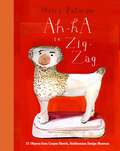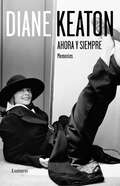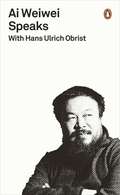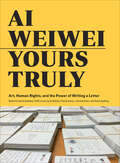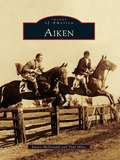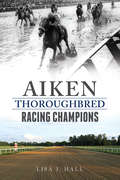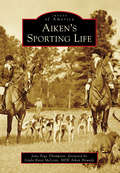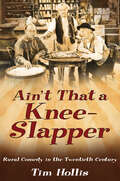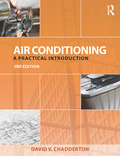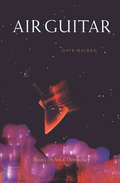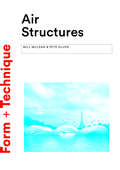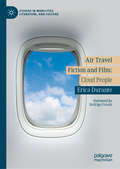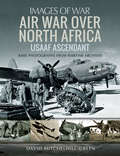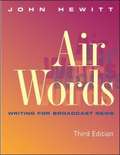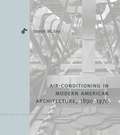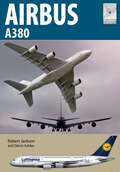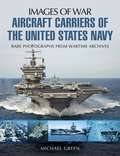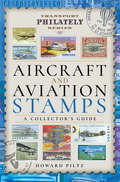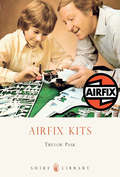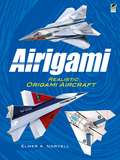- Table View
- List View
Ah-Ha to Zig-Zag: 31 Objects from Cooper Hewitt, Smithsonian Design Museum
by Maira KalmanMaira Kalman’s exuberant illustrations and humorous commentary bring design history to life in this inspired ABC book that celebrates thirty-one objects from the Cooper Hewitt, in time for its long-awaited reopening. "A. Ah-ha! There you Are." begins Maira Kalman’s joyfully illustrated romp through the treasures of Cooper Hewitt’s design collection. With her signature wit and warm humor, Kalman’s ABC book introduces children and adults to the myriad ways design touches our lives. Posing the question "If you were starting a museum, what would you put in your collection?", Kalman encourages the reader to put pen to paper and send in personal letters—an intimate, interactive gesture to top off her unique tour of the world of design. Objects ranging from a thirteenth-century silk thinking cap to 1889 tin slippers with bows, all the way to Gerrit Rietveld’s Zig-Zag chair are brought to colorful life. Kalman’s hand-lettered text is whimsical and universal in turns, drawing lessons as easily from a worn old boot as a masterpiece of midcentury modernism. Irresistibly, we are led to agree, "Everything is design."
Ahora y siempre: Memorias
by Diane KeatonLas memorias íntimas de Diane Keaton «¿Casarme? Yo no quería ser la mujer de nadie. Lo que me apetecía era ser una chica sexi, alguien con quien darse el lote.»Diane Keaton Ahora y siempre es un libro emocionante y divertido como la propia Diane Keaton. Cuenta la historia de una chica corriente que se convirtió en una mujer extraordinaria y el papel fundamental que su madre jugó en todo ello. Esta es la autobiografía de una de las actrices más aclamada de todos los tiempos pero también el relato vital de una madre y una hija, de sus sueños individuales y compartidos.
Ai Weiwei Speaks: with Hans Ulrich Obrist
by Hans Ulrich Obrist'If artists betray the social conscience and the basic principles of being human, where does art stand then?' Ai Weiwei - artist, architect, curator, publisher, poet and urbanist - extended the notion of art and is one of the world's most significant creative and cultural figures. In this series of interviews, conducted over several years with the curator Hans Ulrich Obrist, he discusses the many dimensions of his artistic life, ranging over subjects including ceramics, blogging, nature, philosophy and the myriad influences that have fed into his work. He also talks candidly about his father, his childhood spent in exile and his criticism of the Chinese state. Together, these extraordinary discussions give a unique insight into the outstanding complexity of Ai Weiwei's thought and work, and are an essential reminder of the need for personal, political and artistic freedom.
Ai Weiwei: Yours Truly
by Ai Weiwei Jasmine HeissA chronicle of the Chinese contemporary artist&’s interactive piece on prisoners of conscience, human rights, and the power of art and letter writing. Internationally renowned artist Ai Weiwei works at the intersection of art and politics. In 2014, he created @Large: Ai Weiwei on Alcatraz, an exhibition that engaged nearly 900,000 visitors in a conversation about human rights and freedom of expression. One of the artworks included was Yours Truly. This installation invited visitors to write postcards to prisoners of conscience around the world. On pre-addressed cards depicting the national birds and flowers of the countries where each prisoner was held, visitors wrote messages of hope, humor, and solidarity. In total, 92,829 postcards were written and sent. Ai Weiwei: Yours Truly delves into this astonishing project and invites you to engage with a work of art and a cause. Essays and a statement from the artists himself give a wider artistic and political context. In candid and heartfelt testimonials, five former prisoners and their loved ones—Ahmed Maher, Irom Sharmila Chanu, John Kiriakou, Chelsea Manning, and the family of Ebrahim Sharif Al Sayed—reflect on experiences of activism and detainment, and share the impact of receiving hundreds of postcards from people they would never meet. And photographs from the exhibition show the ordinary people who participated in the projects and some of the messages they wrote. This book is a visually stunning document, an inspiring call-to-arms, and a testament to the power of art to transform lives.
Aiken
by Paul Miles Janice McdonaldIt seems unlikely that a place as far off the beaten track as Aiken, South Carolina, would become the preferred wintering location for the denizens of New York society. But from the late 1800s, the most recognized names in America--the Vanderbilts, the Whitneys, and even the Roosevelts--began coming to this charming Southern city to escape the cold, relax among the oaks, and play. And play they did, establishing Aiken as an international polo capital and a premier place to ride, hunt, and golf. Aiken has so much history beyond the folks known as the winter colonists. Legends of the area's restorative powers date back to Native Americans. Aiken also boasts an amazing number of records, including the destination for the world's longest railroad in 1833 and the second-oldest 18-hole golf course in the United States, the Palmetto Golf Club, built in 1892.
Aiken Thoroughbred Racing Champions (Sports)
by Lisa J. HallSince the 1940s, forty racing champions have traveled the hallowed grounds at the historic Aiken Training Track. Thoroughbred icons such as Kelso, Tom Fool, Swale, Pleasant Colony, Conquistador Cielo and Shuvee trained at this world-renowned track. Numerous members of the Aiken Thoroughbred Racing Hall of Fame won the biggest races in the sport. These champions combined for a total of 546 wins in 1,395 starts, including wins in the Kentucky Derby, the Preakness Stakes and the Belmont Stakes. Race along with author Lisa J. Hall as she pays homage to these equine champions and an Aiken legacy.
Aiken's Sporting Life (Images of America)
by Jane Page Thompson Linda Knox McleanIn 1869, newspaper articles touted Aiken as a health and pleasure resort with the world's largest wooden hotel. Swirling social life and sporting action continued during the war years, when the women of society carried on local traditions. In 1950, Aiken was bustling with scientists and engineers who relocated to work at the Savannah River Site. The last half of the 20th century saw swelling crowds at polo matches, steeplechase races, fox hunts, golf courses, and cultural amusements. In the early 21st century, many Aiken sporting traditions mark milestone anniversaries. At the center of everything is Hitchcock Woods, a woodland paradise, pine-topped cathedral, and equestrian playground that remains open year-round. The Hitchcock Woods Foundation was established to safeguard this treasure within the heart of Aiken. The Aiken Horse Show, held each spring, and Blessing of the Hounds, held on Thanksgiving, are two of the most revered of Aiken's sporting traditions.
Ain't That a Knee-Slapper: Rural Comedy in the Twentieth Century
by Tim HollisThere was a time when rural comedians drew most of their humor from tales of farmers' daughters, hogs, hens, and hill country high jinks. Lum and Abner and Ma and Pa Kettle might not have toured happily under the "Redneck" marquee, but they were its precursors.In Ain't That a Knee-Slapper: Rural Comedy in the Twentieth Century, author Tim Hollis traces the evolution of this classic American form of humor in the mass media, beginning with the golden age of radio, when such comedians as Bob Burns, Judy Canova, and Lum and Abner kept listeners laughing. The book then moves into the motion pictures of the 1930s, 1940s, and 1950s, when the established radio stars enjoyed second careers on the silver screen and were joined by live-action renditions of the comic strip characters Li'l Abner and Snuffy Smith, along with the much-loved Ma and Pa Kettle series of films. Hollis explores such rural sitcoms as The Real McCoys in the late 1950s and from the 1960s, The Andy Griffith Show, The Beverly Hillbillies, Green Acres, Hee Haw, and many others. Along the way, readers are taken on side trips into the world of animated cartoons and television commercials that succeeded through a distinctly rural sense of fun.While rural comedy fell out of vogue and networks sacked shows in the early 1970s, the emergence of such hits as The Dukes of Hazzard brought the genre whooping back to the mainstream. Hollis concludes with a brief look at the current state of rural humor, which manifests itself in a more suburban, redneck brand of standup comedy.
Air Castle of the South: WSM and the Making of Music City
by Craig HavighurstStarted by the National Life and Accident Insurance Company in 1925, WSM became one of the most influential and exceptional radio stations in the history of broadcasting and country music. WSM gave Nashville the moniker "Music City USA" as well as a rich tradition of music, news, and broad-based entertainment. With the rise of country music broadcasting and recording between the 1920s and '50s, WSM, Nashville, and country music became inseparable, stemming from WSM's launch of the Grand Ole Opry, popular daily shows like Noontime Neighbors, and early morning artist-driven shows such as Hank Williams on Mother's Best Flour. Sparked by public outcry following a proposal to pull country music and the Opry from WSM-AM in 2002, Craig Havighurst scoured new and existing sources to document the station's profound effect on the character and self-image of Nashville. Introducing the reader to colorful artists and businessmen from the station's history, including Owen Bradley, Minnie Pearl, Jim Denny, Edwin Craig, and Dinah Shore, the volume invites the reader to reflect on the status of Nashville, radio, and country music in American culture.
Air Conditioning: A Practical Introduction
by David V. ChaddertonDavid Chadderton's Air Conditioning is the complete introduction and reference guide for students and practitioners of air conditioning design, installation and maintenance. The scientific principles involved are introduced with the help of case studies and exercises, and downloadable spreadsheets help you work through important calculations. New chapters on peak summertime air temperature in buildings without cooling systems, air duct acoustic calculations and air conditioning system cost enhance the usefulness to design engineers. Case studies are created from real life data, including PROBE post-occupancy reports, relating all of the theoretical explanations to current practice. Trends and recent applications in lowering energy use by air conditioning are also addressed, keeping the reader informed of the latest sustainable air conditioning technologies. Over 75 multiple choice questions will help the reader check on their progress. Covering both tropical and temperate climates, this is the ideal book for those learning about the basic principles of air conditioning, seeking to understand the latest technological developments, or maintaining a successful HVAC practice anywhere in the world.
Air Guitar
by Dave HickeyThe 23 essays (or "love songs") that make up the now classic volume Air Guitar trawl a "vast, invisible underground empire" of pleasure, through record stores, honky-tonks, art galleries, jazz clubs, cocktail lounges, surf shops and hot-rod stores, as restlessly on the move as the America they depict. Air Guitar pioneered a kind of plain-talking in cultural criticism, willingly subjective and always candid and direct. A valuable reading tool for art lovers, neophytes, students and teachers alike, Hickey's book--now in its third edition--has galvanized a generation of art lovers, with new takes on Norman Rockwell, Robert Mapplethorpe, Stan Brakhage, Andy Warhol and Perry Mason. In June 2009, Newsweek voted Air Guitar one of the top 50 books that "open a window on the times we live in, whether they deal directly with the issues of today or simply help us see ourselves in new and surprising ways," and described the book as "a seamless blend of criticism, personal history, and a deep appreciation for the sheer nuttiness of American life." This is the eBook edition of Air Guitar, originally published in print form in August 1997.
Air Plants: The Curious World of Tillandsias
by Zenaida Sengo Caitlin Atkinson“In this beautiful book, artist Zenaida Sengo has provided inspiration for designing and living with tillandsias.” —Flora GrubbAir Plants, by Zenaida Sengo shows how simple and rewarding it is to grow, craft, and design with these modern beauties. Decorating with air plants is made easy with stunning photographs that showcase ideas for using them mounted on walls, suspended from the ceiling, as living bows and jewelry, as screens, and in unique containers, like leather pouches, dishes, and baskets. Six step-by-step projects include a wood mount, a wall hook, lasso-and-hook wiring, a ceramic-frame garden, and three unique terrariums.
Air Structures
by William McLeanAir can be used in a variety of ways to make lightweight, flexible structures. It can be used to make inflatable structures, mobile structures, and temporary buildings, it can also activate movable elements and act as a means of constructing buildings that would be impossible with conventional construction methods.This book looks at every facet of the subject, examining the different types of air structure: super pressure buildings, air beam structures, buoyant structures, inflatable structures, and many more. It also looks at the construction methods that use air, such as air-inflated steel, aerated concrete and blow moulding. Filled with photographs, models, drawings, and diagrams, this is the ideal book for curious students, designers and architects.
Air Structures (Form + Technique)
by Peter Silver William McLean Pete SilverAir can be used in a variety of ways to make lightweight, flexible structures. It can be used to make inflatable structures, mobile structures, and temporary buildings, it can also activate movable elements and act as a means of constructing buildings that would be impossible with conventional construction methods.This book looks at every facet of the subject, examining the different types of air structure: super pressure buildings, air beam structures, buoyant structures, inflatable structures, and many more. It also looks at the construction methods that use air, such as air-inflated steel, aerated concrete and blow moulding. Filled with photographs, models, drawings, and diagrams, this is the ideal book for curious students, designers and architects.
Air Travel Fiction and Film: Cloud People (Studies in Mobilities, Literature, and Culture)
by Erica DuranteAir Travel Fiction and Film: Cloud People explores how, over the past four decades, fiction and film have transformed our perceptions and representations of contemporary air travel. Adopting an interdisciplinary approach, the book provides a comprehensive analysis of a wide range of international cultural productions, and elucidates the paradigms and narratives that constitute our current imaginary of air mobility. Erica Durante advances the hypothesis that fiction and film have converted the Airworld—the world of airplanes and airport infrastructures—into a pivotal anthropological place that is endowed with social significance and identity, suggesting that the assimilation of the sky into our cultural imaginary and lifestyle has metamorphosed human society into “Cloud People.” In its examination of the representations of air travel as an epicenter of today’s world, the book not only illustrates a novel perspective on contemporary fiction, but fills an important gap in the study of globalization within literary and film studies.
Air War Over North Africa: USAAF Ascendant (Images of War)
by David Mitchelhill-GreenThe decisive role of U.S. Army Air Forces in North Africa is vividly chronicled in this WWII pictorial history featuring rare wartime photographs. In 1942, General Erwin Rommel launched a surprise offensive in North Africa that brought a renewed threat to the Allied forces in the Middle East. United States Army Air Forces were quickly transferred to Egypt to assist the beleaguered British. Unaccustomed to the sprawling deserts of North Africa, the American airmen were confronted by sandstorms, flooding rains, extremes of temperature and primitive living conditions. Beyond these daunting conditions, they were pitted against an experienced and determined enemy. U.S. air power nevertheless played a decisive role in the Allied invasion of Northwest Africa and the subsequent surrender of Axis forces in Tunisia in May 1943. Later bombing missions flown from North Africa struck Axis targets across Europe and supported the Allied invasions of Sicily and mainland Italy. Featuring rare photograph from wartime archives, this volume in the Images of War series presents an illustrated account of U.S. fighter aircraft and bombers—including the iconic B-17 Flying Fortress, P-38 Lightning and B-24 Liberator—and the aircrews that fought to establish ascendancy over North African skies and beyond.
Air Words: Writing for Broadcast News
by John HewittAn introductory text for broadcast newswriting, with numerous exercises and examples illustrating broadcast news style. Defines and explains standard industry formats, rules, and procedures, and covers fact checking, ethics, script formats, shifting from print to broadcast, writing leads, interviews, aspects of TV writing, and copyediting and producing. Includes chapter glossaries. This second edition discusses technology advances such as wire capture and producing from CRTs. Lacks a bibliography. Annotation c. by Book News, Inc., Portland, Or.
Air-Conditioning in Modern American Architecture, 1890–1970 (Buildings, Landscapes, and Societies #11)
by Joseph M. SiryAir-Conditioning in Modern American Architecture, 1890–1970, documents how architects made environmental technologies into resources that helped shape their spatial and formal aesthetic. In doing so, it sheds important new light on the ways in which mechanical engineering has been assimilated into the culture of architecture as one facet of its broader modernist project.Tracing the development and architectural integration of air-conditioning from its origins in the late nineteenth century to the advent of the environmental movement in the early 1970s, Joseph M. Siry shows how the incorporation of mechanical systems into modernism’s discourse of functionality profoundly shaped the work of some of the movement’s leading architects, such as Dankmar Adler, Louis Sullivan, Frank Lloyd Wright, Ludwig Mies van der Rohe, Gordon Bunshaft, and Louis Kahn. For them, the modernist ideal of functionality was incompletely realized if it did not wholly assimilate heating, cooling, ventilating, and artificial lighting. Bridging the history of technology and the history of architecture, Siry discusses air-conditioning’s technical and social history and provides case studies of buildings by the master architects who brought this technology into the conceptual and formal project of modernism.A monumental work by a renowned expert in American modernist architecture, this book asks us to see canonical modernist buildings through a mechanical engineering–oriented lens. It will be especially valuable to scholars and students of architecture, modernism, the history of technology, and American history.
Air-Conditioning in Modern American Architecture, 1890–1970 (Buildings, Landscapes, and Societies)
by Joseph M. SiryAir-Conditioning in Modern American Architecture, 1890–1970, documents how architects made environmental technologies into resources that helped shape their spatial and formal aesthetic. In doing so, it sheds important new light on the ways in which mechanical engineering has been assimilated into the culture of architecture as one facet of its broader modernist project.Tracing the development and architectural integration of air-conditioning from its origins in the late nineteenth century to the advent of the environmental movement in the early 1970s, Joseph M. Siry shows how the incorporation of mechanical systems into modernism’s discourse of functionality profoundly shaped the work of some of the movement’s leading architects, such as Dankmar Adler, Louis Sullivan, Frank Lloyd Wright, Ludwig Mies van der Rohe, Gordon Bunshaft, and Louis Kahn. For them, the modernist ideal of functionality was incompletely realized if it did not wholly assimilate heating, cooling, ventilating, and artificial lighting. Bridging the history of technology and the history of architecture, Siry discusses air-conditioning’s technical and social history and provides case studies of buildings by the master architects who brought this technology into the conceptual and formal project of modernism.A monumental work by a renowned expert in American modernist architecture, this book asks us to see canonical modernist buildings through a mechanical engineering–oriented lens. It will be especially valuable to scholars and students of architecture, modernism, the history of technology, and American history.
Airbus A380 (Flight Craft #23)
by Robert Jackson Glen Ashley“A great addition to the highly popular Flight Craft Series. This book reviews the history of . . . an iconic and important aircraft in civil aviation.” —FiretrenchOn April 27 2005, an aircraft under the power of six massive Rolls-Royce Trent 900 turbofan engines was making its first flight, and it was making history. For this was the Airbus A380, the largest passenger aircraft in the world. With air traffic continuing to double every fifteen years, the A380 was designed by Airbus Industrie to meet the needs of the passengers and airports, while also delivering the level of efficiency necessary to protect the environment for future generations. The design incorporated two full-length decks with wide-body dimensions, meaning its two passenger levels offered an entire deck’s worth of additional space compared to the next largest twin-engine jetliner. With more seats than any other aircraft, the A380 offered solutions to overcrowding; needing fewer journeys to carry 60 percent more passengers, making it the perfect solution to airport congestion, fleet planning optimization and traffic growth. Typical seating capacity was 525, although the aircraft was certified to carry up to 853 passengers. Production of the A380 peaked at thirty aircraft per year in 2012 and 2014. Then, in February 2019, the biggest customer, Emirates, announced that it was to reduce its latest order by thirty-nine aircraft in favour of two other Airbus Models, the A350 and A330neo, a version using the same engines as the Boeing 787 Dreamliner. For Airbus, it was the last act. The Company announced that production of the A380 would cease by 2021.“Full of great information.” —Airport Spotting
Aircraft Carrier Victorious: Detailed in the Original Builders' Plans
by David HobbsThe technical details of British warships were recorded in a set of plans produced by the builders on completion of every ship. Known as the as fitted general arrangements, these drawings represented the exact appearance and fitting of the ship as it entered service. Intended to provide a permanent reference for the Admiralty and the dockyards, these highly detailed plans were drawn with exquisite skill in multi-coloured inks and washes that represent the acme of the draughtsmans art.Today they form part of the incomparable collection of the National Maritime Museum at Greenwich, which is using the latest scanning technology to make digital copies of the highest quality. This book is one of a series based entirely on these draughts which depict famous warships in an unprecedented degree of detail complete sets in full colour, with many close-ups and enlargements that make every aspect clear and comprehensible. Extensive captions point the reader to important features to be found in the plans, and an introduction covers the background to the design.HMS Victorious was a ship with two almost separate incarnations as built in 1941 she was one of a new type of armoured carrier which saw strenuous wartime service; post-war the ship underwent a massive reconstruction lasting nearly eight years that saw her recommission in1958 as one of the best equipped carriers in the world, ready for another decade of duty. Both these phases of the ships life are fully documented, which allows this novel form of anatomy to cover two generations of carrier design.
Aircraft Carriers of the United States Navy: Rare Photographs From Wartime Archives (Images of War)
by Michael GreenThis pictorial history of US aircraft carriers illustrates the many classes and types of carriers used by the navy from before WWII to the present day. In 1922 the US Navy commissioned its first small experimental aircraft carrier. This was followed into service by two much larger carriers in 1927 with five more being built— including three large Yorktown class—prior to the Japanese attack on Pearl Harbor. Then, to take the offensive against the Japanese Navy, the American Congress funded by far the largest carrier-building program in history. Since 1975, when the first of a fleet of ten nuclear-powered Nimitz class carriers was commissioned, The United States Navy&’s fleet of carriers has optimized its superpower status and worldwide power projection. Yet these are due to be replaced in the decades to come with the even more sophisticated nuclear-powered Gerald R. Ford class. Compiled and written by Michael Green, Aircraft Carriers of the United States Navy contains superb images of all the different types of classes of carriers employed by the US Navy since 1922. These and its highly informative text and captions give the reader a broad overview of this fascinating subject.
Aircraft and Aviation Stamps: A Collector's Guide (Transport Philately Series)
by Howard PiltzSoar around the world with this illustrated guide to postage stamps that commemorate the history of flight.In his series of collector’s guides, Howard Piltz combines his two greatest interests: transport and stamps. This volume focuses on aircraft and aviation, highlighting stamps from numerous countries that feature miniature works of art celebrating achievements from early military planes to sleek passenger jets to helicopters, and marking many of the great moments in aviation history.Philatelists and transportation buffs will enjoy not only the photos of stamps themselves but the stories of the author’s research, facts about countries and continents, and some tips and terms for those who are just beginning their adventure in stamp collecting.
Airfix Kits
by Trevor PaskWith the aid of stringy glue and scalpel-sliced fingers, young and old have turned display cabinets and bedrooms into mini-museums, or tiny battlefields. This book looks at the fascinating tale of this British company - a pioneer in the world of modelling - as well as its products, its changing fortunes over the years, and its links with popular culture. Accompanied by color images, Trevor Pask explores this thriving pastime, allowing Airfix kit lovers to indulge in a nostalgic journey and those new to the hobby an intriguing insight into its history.From the Trade Paperback edition.
Airigami: Realistic Origami Aircraft (Dover Origami Papercraft)
by Elmer A. NorvellPaper airplanes never looked so good! A professional pilot and origami expert shows how to fold realistic replicas of nineteen different planes--ten of them airworthy, and nine for display. A private pilot and an ultra-light test pilot, author Elmer A. Norvell is a professional engineer who has served in the U.S. military for more than twenty-four years. His extensive experience informs the design of these realistic models, which range from sleek modern jets to Stukas, Spitfires, and Zeros. Other designs include the Concorde, F-16 Fighting Falcon, F-117 Nighthawk, and XB-70 Valkyrie. Airplane buffs, model makers, and origami enthusiasts alike will appreciate the easy-to-follow diagrams, clear instructions, and photographs of the finished planes in their full glory.
